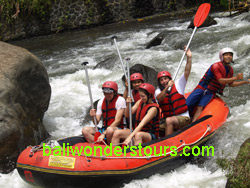Kintamani - Bali Tour Destination

The mountain area is most dramatically first seen if you arrive
at Kintamani.
The main road up to this superb vantage point is the one through
Bangli, and nothing is seen
of the country you are approaching as you ascend until you pass
through a ceremonial gateway and everything is suddenly laid out
before you. Turn right here, where the road swings left having
finally achieved the crater rim, and take a seat in the restaurant
and admire the serenely beautiful spectacle.
What you are actually looking at is a vast caldera, 11 km (6
7/8 miles) across, the hollowed-out remains of a gigantic volcano
that in prehistoric times exploded, blowing away its entire cone
and leaving only the bony, saucer-shaped rim on which you’re
sitting. It’s as of you are in the back row of a circus
that’s in the process of being dismantled; you are looking
down at the ring unaware of the giant big-top tent that once stretch
from just behind your seat to a point high above you.
Mount Batur, whose broken crest rise 1,717 m (5,633 ft) above
sea level, is central to the view. Its slopes are scarred with
lava-flows and all around is a scene of lonely splendor and desolation.
Magnificent though the mountain is, it is the product of more
recent and smaller eruptions and its summit is actually only 328
m (1,066 ft) higher than the outer crater rim at Penelokan.
The volcano is not to be underestimated, however. Its last
major eruption in 1926 completely destroyed the village of Batur,
situated at that time on the western shore of the lake. It was
never rebuilt, but its important temple was relocated up on the
outer-crater rim, and this is now the place meant by Batur Village.

To your right lies Batur Lake, 492 m (160 ft) below you. It
is 8 km (5 miles) long and 3 km (1 7/8 miles) wide and fills almost
a thrd of the area of the caldera. The cliffs that fall abruptly
down to the lake’s eastern edge rise to their maximum height
in the summit of Mount Abang, 3,153 m (10,240 ft) and in a direct
line between Mt.Batur and Mr.Agung.
The righ-hand (eastern) shore of the lake appears to press
right up against these cliffs, but long ago some Bali
Aga remnants, retreating in the face of invaders, found a
flat piece of land and established the village of Trunyan, where
few could be interested in following them. The village is clearly
visible, a prominent patch of red in an otherwise pastel landscape
played over by the changing shadows of the clouds.
At your feet the road zigzags down, branching right to Kedisan
on the lake’s edge immediately below you and continuing
across the lava flows to the hot spring of Air Panas, about halfway
along the left-hand shore.














